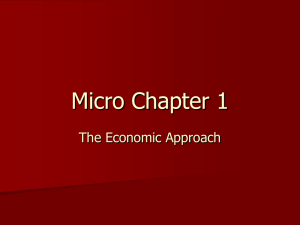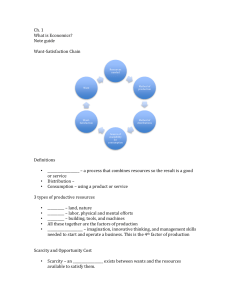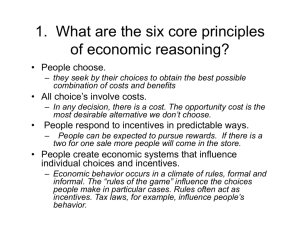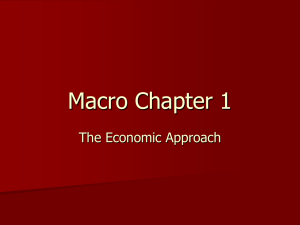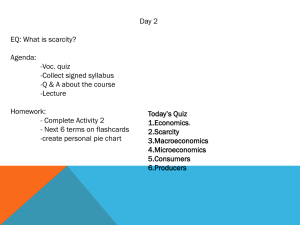What Is Economics About?
advertisement
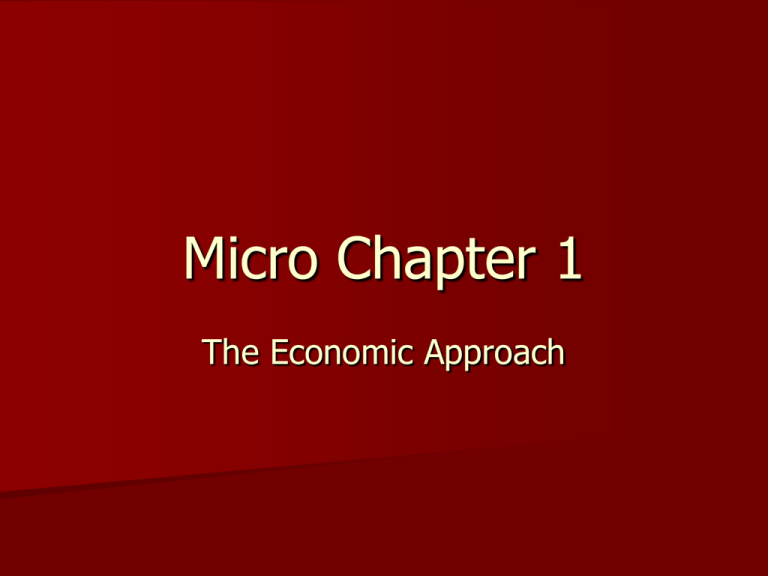
Micro Chapter 1 The Economic Approach 4 Learning Goals 1) Identify and list the critical components of economics. 2) List and provide examples of the eight guideposts of economic thinking. 3) Distinguish between two types of economic statements (on your own) 4) Avoid making four common mistakes Compare and Contrast: A. All the possessions you have right now B. All the possessions you had 10 years ago Which group would you rather have? Why? Improving standards of living doesn’t just happen by accident Actually, they don’t have to improve at all Video: A Deal for You: Would you give up the internet for the rest of your life for $1 million right now? A Deal for You: Would you give up the internet for the rest of your life for $1 million right now? Video: What Is Economics About? Economics doesn’t have to be like this: Economics tries to explain and predict the behavior of consumers, firms, and government. John M. Keynes: “Economics does not furnish a body of settled conclusions immediately applicable to policy. It is a method rather than a doctrine, an apparatus of the mind, a technique of thinking which helps its possessor to draw correct conclusions.” Steven Levitt & Stephen Dubner Super Freakonomics The economic approach isn’t meant to describe the world as any one of us might want it to be, or fear that it is, or pray that it becomes- but rather to explain what it actually is. Most of us want to fix or change the world in some fashion. But to change the world, you first have to understand it. Supplemental video: RSAnimateFreakonomics (on Blackboard) Scarcity and Tradeoffs Scarcity leads to tradeoffs which result in making choices Scarcity and Tradeoffs Thomas Sowell: “In the world that people live in, and are likely to live in for centuries to come, trade-offs are inescapable. Even if we refuse to make a choice, circumstances will make choices for us, as we run out of resources for many important things that we could have had, if only we had taken the trouble to weigh alternatives. ” Historically, mechanisms that have been used to deal with the problem of scarcity: 1. Force 2. Tradition (emphasized past ways, relied on families) 3. Authority (government and church) 4. Market 5. Combinations of 1-4 Scarcity and Tradeoffs Scarcity requires that some wants remain unfulfilled Issues of equity, justice, and fairness are embedded with scarcity Class Perspective We will focus on the market process of dealing with scarcity. At times we will compare and contrast with the government or collectivist process. Do not confuse the market process as being the same as politically conservative. The Economic Way of Thinking Always have these guidelines in your economic thought process: The text lists 8 guidelines. (1) There are always tradeoffs (1) There are always tradeoffs What you give up is your opportunity costvalue of next best alternative Common mistake: opportunity cost is NOT the sum of everything you give up (1) There are always tradeoffs There is no such thing as a free lunch! (1) There are always tradeoffs Supplemental video: Milton Friedman- free lunch myth (on Blackboard) (2) Individuals choose purposefully Referred to as economizing behavior-try to get the most benefits for the least cost or effort Also known as rational behavior Example: drug addict Alfred Marshall: “It is deliberateness, and not selfishness, that is the characteristic of the modern age. Steven Levitt & Stephen Dubner Super Freakonomics Human behavior is influenced by a dazzlingly complex set of incentives, social norms, framing references, and the lessons gleaned from past experience- in a word, context. We act as we do because, given the choices and incentives at play in a particular circumstance, it seems most productive to act that way. This is also known as rational behavior, which is what economics is all about. Clicker question next When economists say that people choose rationally, this means 1. they gather all relevant information before making their purchases 2. once a pattern of behavior has been established, people tend to become set in their ways 3. people respond in predictable ways to changes in costs and benefits 4. people rarely make errors when they are permitted to make transactions (3) Incentives matter As the incentive goes up, you will be more likely to do something (or try to), and vice versa The incentive doesn’t have to be money Class Activity: What are some of your incentives? (3) Incentives Matter Video: (3) Incentives matter Illustration: Dancing (3) Incentives matter Illustration: Dancing 1: (3) Incentives matter Illustration: Dancing 1: 2: 3: Thank you! (3) Incentives Matter Supplemental reading: Flamboyant male dancing attracts women best Supplemental video: RSAnimatesurprising truth about what motivates (on Blackboard) (4) Think on the margin, not in total or on average Marginal means additional or incremental Marginal _______ is additional _______. Marginal _______ is additional _______. Example: water/diamond paradox Example: Would you travel 3 blocks to save $20 on a $100 product? Would you travel the same 3 blocks to save $20 on a $1,000 product? (4) Think on the margin, not in total or on average Rule to live by: Continue to engage in an activity as long as the expected marginal benefit is greater than the expected marginal cost. When should you break up with your boyfriend? (5) More information leads to better decision-making, but more information is costly to get Refer back to (1) through (4) 1) 2) 3) 4) There are always tradeoffs Individuals choose purposefully Incentives matter Think on the margin (6) Many choices create a secondary effect The primary effect is often immediate and visible The secondary effect usually comes later and is not as visible Video: (7) Value is subjective Beauty is in the eyes of the beholder Value is determined by the purchaser (8) Economic thinking is scientific thinking Economists use data and information generated by people to explain and predict actions Clicker question next Do you believe red cars receive more traffic tickets? 1. Yes 2. No (8) Economic thinking is scientific thinking Economists use data and information generated by people to explain and predict actions Class Activity: Do you believe that red cars receive more traffic tickets? Why or why not? Video: Steven Levitt & Stephen Dubner Super Freakonomics But while there are exceptions to every rule, it’s also good to know the rule. In a complex world where people can be atypical in an infinite number of ways, there is great value in discovering the baseline. And knowing what happens on average is a good place to start. By so doing, we insulate ourselves from the tendency to build our thinking- our daily decisions, our laws, our governance- on exceptions and anomalies rather than on reality. (8) Economic thinking is scientific thinking Do you believe that students who regularly attend class earn higher grades? How could you support (or fail to support) that? See David Romer’s article “Do students go to class? Should they?” on Blackboard Positive and Normative Economics 4 Learning Goals 3) Distinguish between two types of economic statements (on your own) Please read “Essays in Positive Economics” by Milton Friedman on Blackboard The introduction and Section 1 (pages 1 through 3) are relevant; you may skip the rest. Pitfalls To Avoid in Economic Thinking Don’t make one of these errors: (1) Violation of ceteris paribus. – Ceteris paribus is Latin for “other things constant.” – We want to isolate variables so we typically allow only one to change at a time. – Example: stomach ache Errors: (2) Good intentions do not necessarily result in good outcomes Milton Friedman: “There is nothing that does so much harm as good intentions” Errors: (2) Good intentions do not necessarily result in good outcomes Example: using someone else’s device for clicker credit Errors: (3) Association is NOT causation Video: Errors: (3) Association is NOT causation Some examples Video: Errors: (4) Fallacy of Composition – Assumption: what’s good for the individual is good for the group. – Making this assumption when it’s false is the fallacy. – Video: Class Activity Provide at least one example of the fallacy of composition. 4 Learning Goals 1) Identify and list the critical components of economics. 2) List and provide examples of the eight guideposts of economic thinking. 3) Distinguish between two types of economic statements (on your own) 4) Avoid making four common mistakes
